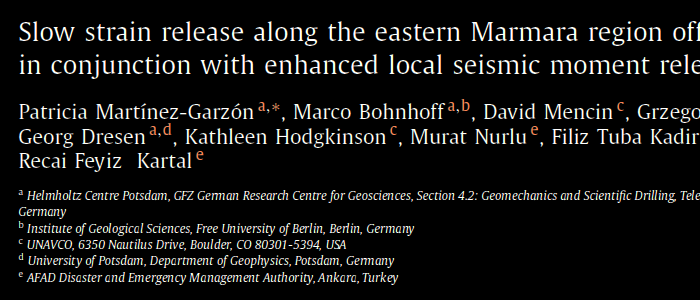We recently published a paper in Earth and Planetary Science Letters entitled “Slow strain release along the eastern Marmara region offshore Istanbul in conjunction with enhanced local seismic moment release”.
The paper was quite widely commented in a GFZ press release, as well as in the Science Daily and Phys.org.
Full reference:
Martínez-Garzón, P., M. Bohnhoff, D. Mencin, G. Kwiatek, G. Dresen, K. Hodgkinson, M. Nurlu, F. T. Kadirioglu, and R. F. Kartal (2019). Slow strain release along the eastern Marmara region offshore Istanbul in conjunction with enhanced local seismic moment release, Earth and Planetary Science Letters 510, 209–218, DOI: 10.1016/j.epsl.2019.01.001.
Abstract:
We analyze a large transient strainmeter signal recorded at 62.5 m depth along the southern shore of the eastern Sea of Marmara region in northwestern Turkey. This region represents a passage of stress transfer from the Izmit rupture to the Marmara seismic gap. The strain signal was recorded at the Esenkoy site by one of the ICDP-GONAF (International Continental Drilling Programme – Geophysical Observatory at the North Anatolian Fault) strainmeters on the Armutlu peninsula with a maximum amplitude of 5 microstrain and lasting about 50 days. The onset of the strain signal coincided with the origin time of a MW 4.4 earthquake offshore Yalova, which occurred as part of a seismic sequence including eight MW ≥3.5 earthquakes. The MW 4.4 event occurred at a distance of about 30 km from Esenkoy on June 25th 2016 representing the largest earthquake in this region since 2008. Before the event, the maximum horizontal strain was subparallel to the regional maximum horizontal stress derived from stress inversion of local seismicity. During the strain transient, we observe a clockwise rotation in the local horizontal strain field of about 20°. The strain signal does not correlate with known environmental parameters such as annual changes of sea level, rainfall or temperature. The strain signal could indicate local slow slip on the Cinarcik fault and thus a transfer of stress to the eastern Marmara seismic gap.
